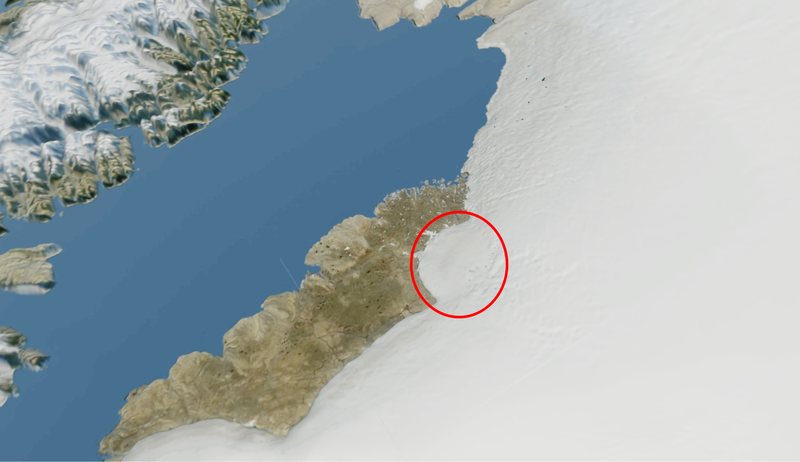 The location of the 19-mile-wide (31 kilometers) impact crater in northwestern Greenland.Image: The Natural History Museum of Denmark
The location of the 19-mile-wide (31 kilometers) impact crater in northwestern Greenland.Image: The Natural History Museum of Denmark
An unusually large asteroid crater measuring 19 miles wide has been discovered under a continental ice sheet in Greenland. Roughly the size of Paris, it’s now among the 25 biggest asteroid craters on Earth.
An iron-rich asteroid measuring nearly a kilometer wide (0.6 miles) struck Greenland’s ice-covered surface at some point between 3 million and 12,000 years ago, according to a new study published today in Science Advances.
Location of the Hiawatha impact crater.Image: University of Kansas
The impact would’ve flung horrific amounts of water vapor and debris into the atmosphere, while sending torrents of meltwater into the North Atlantic—events that likely triggered global cooling (a phenomenon sometimes referred to as a nuclear or volcanic winter). Over time, however, the gaping hole was obscured by a 1,000-meter-tall (3,200-foot) layer of ice, where it remained hidden for thousands of years.
Remarkably, the crater was discovered quite by chance—and it’s now the first large crater to be discovered beneath a continental ice sheet.
“In 2015 I was looking at a new map of the bedrock below the Greenland Ice Sheet and discovered a large circular feature under the Hiawatha glacier in northwest Greenland,” Nicolaj K. Larsen, a co-author of the study and a geoscientist at Aarhus University, told Gizmodo. “In other words, it was a coincidence that the crater was discovered.”
Larsen, along with his colleague Kurt Kjaer from the Natural History Museum of Denmark, immediately recognized that they had stumbled upon something special, but it soon became apparent that the depression would be hard to confirm as a remnant of an ancient asteroid strike.
The first step was to analyze aerial surveys taken of Greenland from 1997 to 2014 by researchers from the University of Kansas. But the data resolution of these surveys “was not sufficient,” according to Larsen, so a team was sent to Greenland to collect superior, higher-resolution ice-radar data of the Hiawatha glacier and the bedrock beneath. This was accomplished in 2016 using wideband ground-penetrating radar (or in this case, ice-penetrating radar) developed at the University of Kansas.
That said, signs of the impact crater were also visible to the naked eye.
“You can see the rounded structure at the edge of the ice sheet, especially when flying high enough,” John Paden, a co-author of the study and an engineer at the University of Kansas, said in a statement. “For the most part the crater isn’t visible out the airplane window. It’s funny that until now nobody thought, ‘Hey, what’s that semicircular feature there?’ From the airplane it is subtle and hard to see unless you already know it’s there. Using satellite imagery taken at a low sun angle that accentuates hills and valleys in the ice sheet’s terrain—you can really see the circle of the whole crater in these images.”
An illustration of an airplane using radar to map the topography below the ice sheet. Image: NASA
Next, the scientists visited the edge of the glacier to collect river samples. Some of the minerals they analyzed exhibited the telltale characteristics of a catastrophic impact, such as shocked quartz grains and other impact-related grains, such as glass.
Some pre-glacial channels were seen below the ice sheet at the site of the crater, which suggests the Greenland Ice Sheet was already in place when the asteroid struck. The exact timing of the asteroid strike, however, is fairly vague, with the researchers saying it happened between 3 million and 12,000 years ago. But preliminary evidence suggests it happened relatively recently. The crater appears to be well-preserved—a surprising observation given that ice is a powerful erosive force. The crater is likely fairly young from a geological perspective.
“It is correct that the crater is not well dated but there’s good evidence that it is geologically young, that is, it formed within the last 2 to 3 million years, and most likely it is as young as the last Ice Age [which ended around 12,000 years ago],” Larsen explained to Gizmodo. “We are currently trying to come up with ideas on how to date the impact. One idea is to drill through the ice and get bedrock samples that can be used for numerical dating.”
Also, the incident was severe enough such that evidence of the impact should be detectable elsewhere on the planet. The impact likely triggered a global cooling event by delivering copious amounts of debris, dust, and water vapor into the atmosphere, blocking incoming solar radiation. At the same time, melting ice from Greenland’s ice sheet would’ve reached the North Atlantic, causing a weakening or shutting down of the North Atlantic current—the current that provides western and northern Europe with its relatively mild climate. Evidence of the impact should thus exist within our planet’s stratigraphy, allowing for more precise dating of the impact. Archaeologists and anthropologists could also help in this regard, to see if and when ancient populations of humans were affected by an asteroid strike dating back to this time period.
The discovery of this previously unknown impact crater in Greenland is welcome news, both in terms of our learning about it, and the future scientific work it’s sure to inspire. Confirming the existence of this crater is just the first step—there’s now plenty of related work to be done.
[Science Advances]
Share This Story